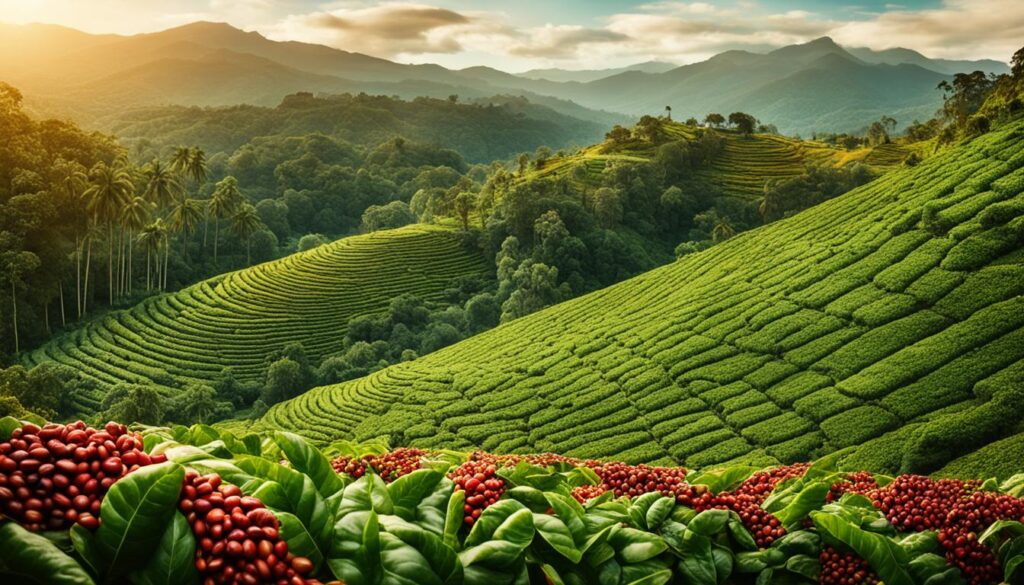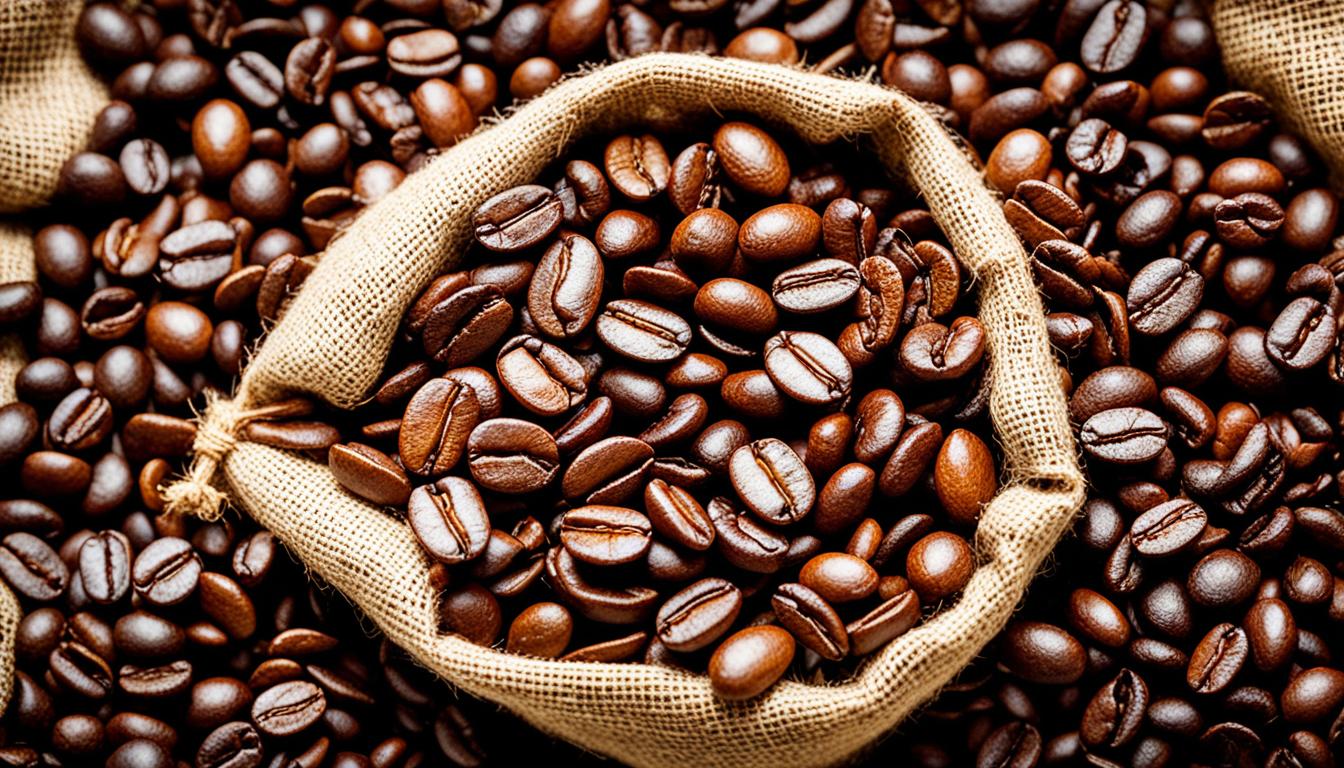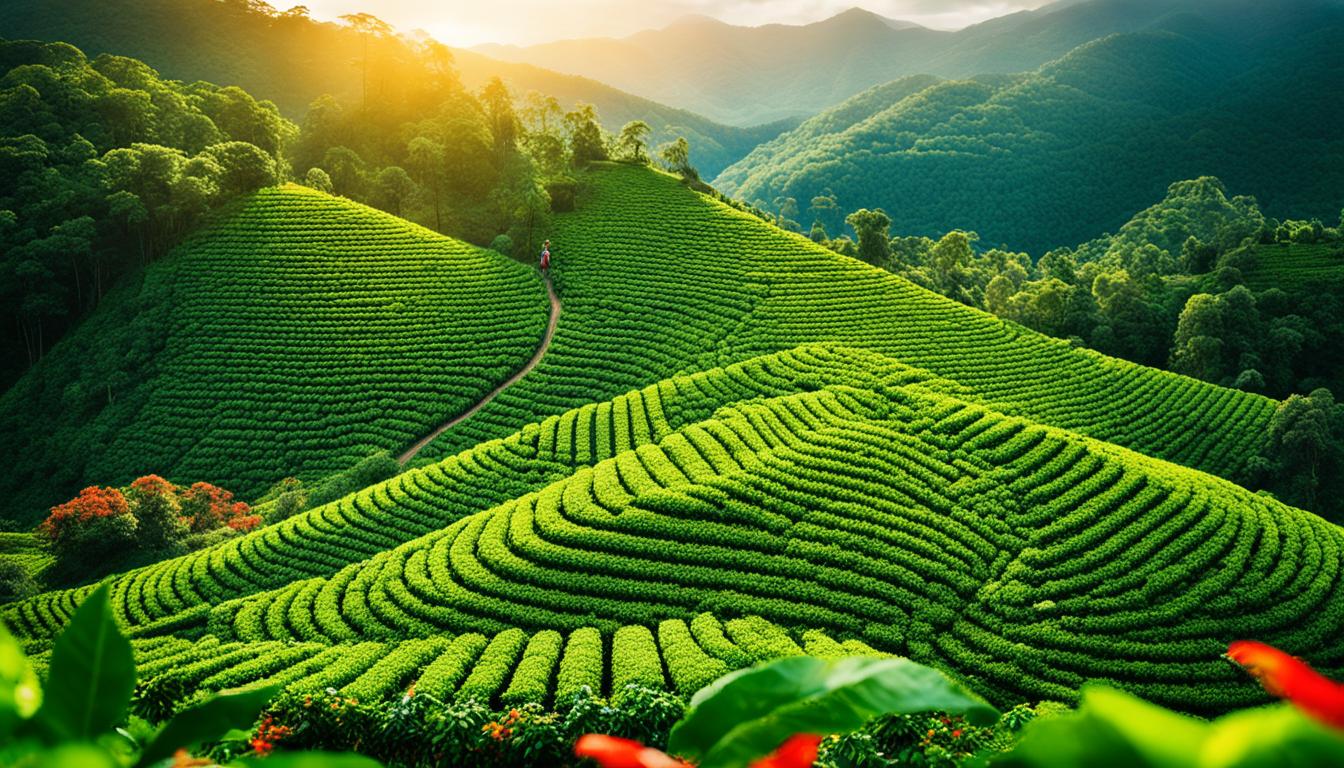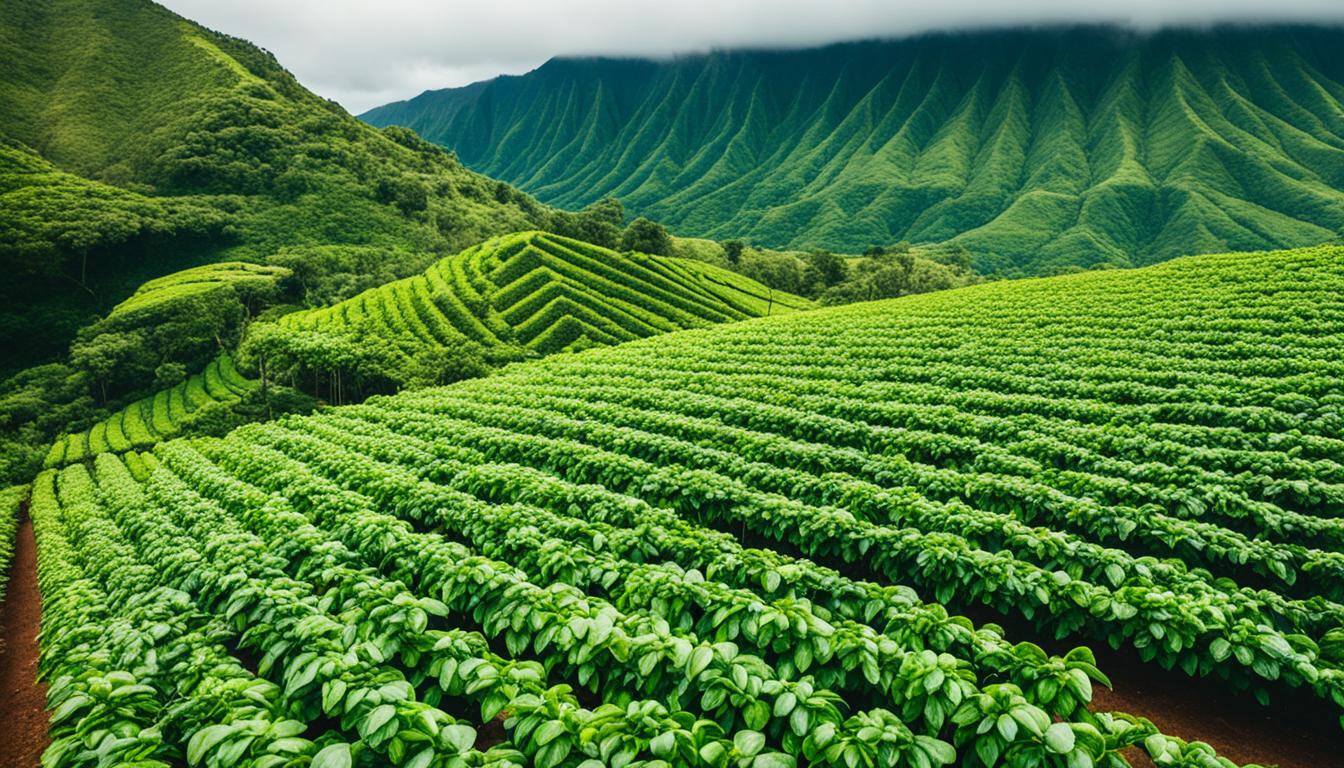Welcome to our coffee journey through the heart of Central America, where we dive deep into the world of rich flavors, aromatic brews, and exceptional coffee beans. Central America is a treasure trove for coffee connoisseurs, offering a diverse range of specialty brews that satisfy even the most discerning palates. Join us as we explore the vibrant coffee culture in this region, delving into its history, plantations, and the renowned Arabica beans that make Central American coffee truly exceptional.
Key Takeaways:
- Coffee in Central America offers a rich array of flavors and aromas.
- Central American coffee is renowned worldwide for its exceptional quality.
- The region hosts a variety of coffee plantations that cultivate the finest Arabica beans.
- Central American coffee has its unique characteristics, including balanced acidity and smooth mouthfeel.
- When it comes to coffee in Central America, exploring fair trade and organic options adds to the experience.
What is Central American coffee?
Central American coffee refers to coffee beans cultivated in the countries located in the Central American region, including Costa Rica, El Salvador, Guatemala, Honduras, Mexico, and Nicaragua. These countries boast fertile soil, ideal climate conditions, and rich coffee-growing traditions, resulting in a diverse range of high-quality coffee beans.
Central American coffee is highly esteemed for its exquisite flavors, enticing aromas, and unique characteristics. The combination of volcanic soils, high altitudes, and tropical climates provides the perfect environment for cultivating exceptional coffee beans.
The coffee plantations in Central America are known for their commitment to sustainable and ethical practices. Many farmers in the region prioritize organic cultivation methods and fair trade standards, ensuring the preservation of the environment and the welfare of coffee workers.
With their passion for coffee and centuries-old traditions, Central American countries have built a reputation for producing some of the finest Arabica coffee beans in the world. These beans are cultivated with meticulous care, hand-picked at the peak of ripeness, and processed using advanced techniques to enhance their flavors.
“Coffee and Central America share a bond that goes beyond agriculture. It’s a cultural heritage, a way of life. The art of coffee production has been passed down through generations, and the result is a cup that tells a story of history, craftsmanship, and unmatched richness.”
Central American coffee is often characterized by its vibrant acidity, medium body, and delightful flavor profiles. From the bright and fruity notes of Costa Rican beans to the chocolatey undertones found in Guatemalan varieties, each cup of Central American coffee promises a delightful sensory experience.
Experience the essence of Central American coffee by savoring a freshly brewed cup of your favorite variety. It’s an opportunity to embark on a flavor-filled journey and appreciate the craftsmanship behind every sip.
The Central American Coffee Regions
Each Central American country holds its own unique coffee heritage and contributes distinct flavors to the coffee world. Let’s take a closer look at the coffee regions in Central America:
| Country | Main Coffee Regions |
|---|---|
| Costa Rica | Tarrazu, Tres Rios, Central Valley |
| El Salvador | Santa Ana, Apaneca-Ilamatepec, Chalatenango |
| Guatemala | Huehuetenango, Antigua, Coban |
| Honduras | Copan, Montecillos, Ocotepeque |
| Mexico | Veracruz, Chiapas, Oaxaca |
| Nicaragua | Matagalpa, Jinotega, Nueva Segovia |
Each region has its own microclimate, altitude, and soil composition, influencing the flavors exhibited in each cup. Exploring coffee from different Central American regions allows you to experience the rich diversity and flavors that make this region renowned among coffee enthusiasts.
Next, we’ll delve into the flavors, profiles, and unique characteristics of the best coffees in Central America, guiding you in your quest to find your perfect cup.
What is the best coffee in Central America?
The best coffee in Central America is subjective and can vary depending on personal preferences. However, some of the most highly regarded coffees from the region include:
- Costa Rican Tarrazu: Known for its smooth flavor and bright acidity, Costa Rican Tarrazu coffee is celebrated for its exceptional quality. Grown in the Tarrazu region, this coffee offers a distinct and rich flavor profile.
- Guatemalan Huehuetenango: Hailing from the Huehuetenango region in Guatemala, this coffee is characterized by its vibrant acidity and complex flavors. With hints of caramel and fruit, it provides a truly unique taste experience.
- Salvadoran Finca Hungria: From the beautiful Finca Hungria estate in El Salvador, this coffee showcases a balanced flavor profile with notes of chocolate and citrus. It is known for its smooth body and delicate aroma.
These coffees have gained recognition for their exceptional quality, distinct flavor profiles, and aromatic characteristics. Whether you prefer a smooth and rich Costa Rican Tarrazu, a bright and complex Guatemalan Huehuetenango, or a balanced and flavorful Salvadoran Finca Hungria, Central America offers a diverse selection of the best coffee experiences.
Experience the richness of Central American coffee by indulging in the flavors and complexities that these renowned coffees have to offer.
What is the difference between Central and South American coffee?
When it comes to Central and South American coffee, there are several key distinctions that set them apart. From flavor profiles to growing conditions and processing methods, these factors contribute to the unique characteristics found in each cup. Let’s delve into the nuances that differentiate Central and South American coffee.
Flavor Profiles
Central American coffees, including those from Costa Rica, Guatemala, and El Salvador, offer a bright acidity, medium body, and nuanced flavors. With cleaner, more balanced profiles, they provide a delightful sensory experience. These coffees typically exhibit a slightly less sweet taste compared to their South American counterparts, accompanied by a subtle chocolatey aroma.
On the other hand, South American coffees, including those from Brazil and Colombia, tend to present a milder acidity and heavier body. Their flavor profiles often showcase rich chocolate notes, caramel sweetness, and nutty undertones.
Growing Conditions
The variations in climate and geography give rise to distinct growing conditions between Central and South American coffee regions. Central American countries such as Costa Rica and Guatemala are known for their high-altitude coffee plantations, providing ideal conditions for Arabica coffee cultivation. The volcanic soils, coupled with the optimal temperature range and abundant rainfall, contribute to the exceptional quality of Central American coffee beans.
In contrast, South American coffee, particularly from Brazil, benefits from lower-altitude plantations and a more tropical climate. These conditions promote the growth of Brazil’s predominant coffee variety, Arabica, as well as the robust and disease-resistant Robusta beans.
Processing Methods
The processing methods employed in Central and South American coffee production also vary. Central American countries often employ the traditional washed or wet processing method, which involves removing the coffee cherry fruit before fermenting and washing the beans. This technique results in a clean and bright cup with balanced flavors.
In South America, particularly in Brazil, the natural or dry processing method is commonly used. In this method, coffee cherries are dried in the sun before removing the fruit, allowing the beans to naturally absorb sugars and flavors from the pulp. This imparts unique characteristics to the coffee, leading to a full-bodied and fruit-forward taste.
“The variations in flavor, growing conditions, and processing methods between Central and South American coffees offer coffee enthusiasts an array of choices that cater to different preferences and palates.”
As we explore the world of coffee, it’s fascinating to witness the diverse outcomes that can arise from variations in flavor, farming techniques, and regional traditions. Central and South American coffee exemplify the richness and complexity that can be found within a single bean, each offering its own unique story with every sip.
| Key Differences | Central American Coffee | South American Coffee |
|---|---|---|
| Flavor Profile | Bright acidity, medium body, nuanced flavors | Milder acidity, heavier body, rich chocolate notes, caramel sweetness, nutty undertones |
| Growing Conditions | High-altitude plantations, volcanic soils, optimal temperature range | Lower-altitude plantations, tropical climate |
| Processing Methods | Washed or wet processing | Natural or dry processing |

Which Central American Countries Produce Coffee?
Central America is home to several countries renowned for their exceptional coffee production. Let’s explore some of the prominent coffee-producing countries in the region:
Costa Rica Coffee
– Costa Rica was the first Central American country to cultivate coffee on a commercial scale.
– Coffee cultivation in Costa Rica traces back to 1729.
– Costa Rican coffee is renowned for its exceptional quality, particularly from the Tarrazu region.
– Only Arabica beans are cultivated in Costa Rica, with Robusta strictly prohibited.
– The finest beans thrive at altitudes exceeding 1,500 meters above sea level, earning the designation “SHB” or Strictly Hard Bean.
El Salvador Coffee
– El Salvador is known for producing high-quality Arabica coffee.
– The country’s unique microclimates provide ideal conditions for growing specialty coffee beans.
– El Salvadorian coffee often exhibits a well-balanced flavor profile with hints of citrus, chocolate, and caramel.
– Coffee plays a crucial role in the country’s economy, contributing to the livelihood of many local communities.
Guatemala Coffee
– Guatemala is famous for its diverse coffee regions, each offering a unique flavor profile.
– Antigua, Huehuetenango, and Coban are some of the renowned coffee-producing regions in the country.
– Guatemalan coffee is known for its vibrant acidity, full body, and distinct chocolate and fruity notes.
– The country’s volcanic soil and high altitudes contribute to the exceptional quality of its coffee beans.
Honduras Coffee
– Honduras is the largest coffee producer in Central America.
– The country’s mountainous terrain and fertile soil create ideal conditions for coffee cultivation.
– Honduran coffee is appreciated for its balanced acidity, medium body, and flavors ranging from citrus to chocolate.
– The coffee industry plays a crucial role in providing employment opportunities for many Honduran farmers.
Mexico Coffee
– Mexico has a rich coffee tradition dating back to the 18th century.
– Mexican coffee beans are known for their smooth, medium body and delicate flavor profiles.
– Chiapas and Veracruz are among the prominent coffee-growing regions in Mexico.
– Mexican coffee often exhibits flavors of nuts, caramel, and cocoa, with a hint of brightness.
Nicaragua Coffee
– Nicaragua is considered one of the finest coffee-producing countries in Central America.
– The country’s diverse microclimates contribute to the unique flavors found in Nicaraguan coffee.
– Nicaraguan coffee is characterized by its bright acidity, medium body, and flavors of chocolate, nuts, and fruit.
– The industry plays a significant role in the country’s economy, providing employment to many Nicaraguan farmers.
As you can see, Central America boasts a rich and diverse coffee heritage. Each country contributes its unique flavors, traditions, and excellence to the world of coffee. Discovering the distinct characteristics of Costa Rican, Salvadoran, Guatemalan, Honduran, Mexican, and Nicaraguan coffees is a delightful exploration for coffee enthusiasts around the globe.
| Country | Main Coffee Regions | Flavor Profile | Production Volume |
|---|---|---|---|
| Costa Rica | Tarrazu, Central Valley | Rich, vibrant, with hints of citrus and chocolate | Approximately 1.5 million bags per year |
| El Salvador | Apaneca-Ilamatepec, Chalatenango | Balanced, citrusy, with notes of chocolate and caramel | Approximately 900,000 bags per year |
| Guatemala | Antigua, Huehuetenango, Coban | Vibrant acidity, full body, chocolate, and fruity notes | Approximately 3.5 million bags per year |
| Honduras | Comayagua, Copan, Ocotepeque | Balanced acidity, medium body, citrus to chocolate flavors | Approximately 7.5 million bags per year |
| Mexico | Chiapas, Veracruz, Oaxaca | Smooth, medium body, notes of nuts, caramel, and cocoa | Approximately 4.5 million bags per year |
| Nicaragua | Jinotega, Matagalpa, Nueva Segovia | Bright acidity, medium body, chocolate, nuts, and fruit flavors | Approximately 2.5 million bags per year |
Regional Characteristics of Central American Coffee
Central American coffees are known for their unique flavor profiles and distinct characteristics. Let’s explore the regional characteristics that make Central American coffee stand out from the rest.
Acidity
Central American coffees exhibit moderate to high acidity levels, giving them a vibrant and lively taste. This acidity adds brightness to the cup and contributes to a refreshing and tangy sensation on the palate.
Body and Mouthfeel
When it comes to body and mouthfeel, Central American coffees typically have a light to moderate body. This means that they feel rather delicate and smooth in the mouth. The combination of acidity and body creates a balanced and enjoyable drinking experience.
Roast
The roast level for Central American coffees tends to fall between medium and Vienna. This roast profile allows the inherent flavors of the beans to shine while maintaining a good balance of sweetness and acidity.
Flavor Tones
Central American coffees are often characterized by their vibrant and complex flavor profiles. They are known for their fruity notes, which can range from citrusy and berry-like to tropical fruit flavors. Additionally, Central American coffees may feature honey-like sweetness and medium-to-dark chocolate undertones. A subtle nuttiness often lingers in the base notes, adding depth and richness to the overall flavor profile.
Let’s dive deeper into the intriguing world of Central American coffee through an enticing table that showcases the flavor characteristics and regional nuances:
| Coffee Origin | Taste Profile | Flavor Notes |
|---|---|---|
| Costa Rica | Balanced and Bright | Red fruits, honey, milk chocolate |
| Guatemala | Rich and Complex | Stone fruits, dark chocolate, caramel |
| Honduras | Smooth and Vibrant | Blackcurrant, brown sugar, almond |
| Nicaragua | Crisp and Velvety | Citrus, floral, dark chocolate |
By understanding these regional characteristics, we can better appreciate the nuanced flavors that Central American coffee has to offer. Next, we’ll conclude our exploration of Central American coffee with a fitting summary.
Conclusion
Central America’s rich coffee heritage offers a myriad of flavors and experiences for discerning coffee enthusiasts. From the lush plantations of Costa Rica to the volcanic slopes of Guatemala, each cup tells a story of passion, tradition, and unparalleled quality.
As we’ve explored in this article, Central America’s coffee-producing countries, including Costa Rica, El Salvador, Guatemala, Honduras, Mexico, and Nicaragua, have perfected the art of cultivating the finest coffee beans. Their fertile soils, ideal climate conditions, and commitment to quality have made Central American coffee a global favorite.
Whether you prefer the vibrant acidity of Costa Rican Tarrazu, the rich complexity of Guatemalan Huehuetenango, or the delicate sweetness of Salvadoran Finca Hungria, Central American coffee has something for every palate. The region’s coffees are defined by their balanced profiles, bright flavors, and smooth texture.
So, embark on a coffee journey through Central America, and experience the essence of coffee excellence. Discover the unique characteristics, the passionate people behind each cup, and the traditions that have made Central American coffee world-renowned. Savor the distinct flavors and aromas that only Central American coffee can deliver, and immerse yourself in a truly exceptional coffee experience.
FAQ
What is Central American coffee?
Central American coffee refers to coffee beans cultivated in the countries located in the Central American region, including Costa Rica, El Salvador, Guatemala, Honduras, Mexico, and Nicaragua. These countries boast fertile soil, ideal climate conditions, and rich coffee-growing traditions, resulting in a diverse range of high-quality coffee beans.
What is the best coffee in Central America?
The best coffee in Central America is subjective and can vary depending on personal preferences. However, some of the most highly regarded coffees from the region include Costa Rican Tarrazu, Guatemalan Huehuetenango, and Salvadoran Finca Hungria. These coffees are renowned for their exceptional quality, distinct flavor profiles, and aromatic characteristics.
What is the difference between Central and South American coffee?
The main difference between Central and South American coffee lies in their flavor profiles, growing conditions, and processing methods. Central American coffees, including those from Costa Rica, Guatemala, and El Salvador, are often characterized by their bright acidity, medium body, and nuanced flavors. They tend to have cleaner, more balanced profiles compared to South American coffees and are typically described as slightly less sweet with a more subtle chocolatey aroma.
Which Central American countries produce coffee?
Several Central American countries produce coffee, including Costa Rica, El Salvador, Guatemala, Honduras, Mexico, and Nicaragua. Each country has its own unique coffee-growing regions and distinct flavor profiles.
What are the characteristics of Central American coffee?
Central American coffees have moderate to high acidity. They have a light to moderate body and moderate mouthfeel. The roast for these coffees is typically medium to Vienna roast. Common identifying words for Central American coffees are balanced, bright, clean, and smooth. Prominent flavor tones include fruits, honey, and medium-to-dark chocolate, with a hint of nut often found in the base notes.




